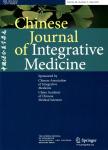Analysis of Chinese Medical Syndrome Features of Ischemic Stroke Based on Similarity of Symptoms Subgroup
作者机构:Department of NeurologyDongzhimen HospitalBeijing University of Chinese MedicineBeijing(100700)China Department of GastroenterologyGuanganmen HospitalChina Academy of Chinese Medical SciencesBeijing(100053)China School of Computer and Information Technology and Beijing Key Lab of Traffic Data Analysis and MiningBeijing Jiaotong UniversityBeijing(100044)China Department of NeurologyWeifang Hospital of Traditional Chinese MedicineWeifangShandong Province(261041)China Beijing Zhong Teng Bai Mai Medical Technology Co.Ltd.Beijing(100027)China Institute of Basic Research in Clinical MedicineChina Academy of Chinese Medical SciencesBeijing(100700)China Department of RadiologyDongzhimen HospitalBeijing University of Chinese MedicineBeijing(100700)China School of Life SciencesBeijing University of Chinese MedicineBeijing(100029)China Department of OtolaryngologyDongzhimen HospitalBeijing University of Chinese MedicineBeijing(100029)China Department of PsychiatryMassachusetts General HospitalHarvard Medical SchoolBoston(MA 02115)United States
出 版 物:《Chinese Journal of Integrative Medicine》 (中国结合医学杂志(英文版))
年 卷 期:2023年第29卷第5期
页 面:441-447页
核心收录:
学科分类:1006[医学-中西医结合] 1002[医学-临床医学] 100602[医学-中西医结合临床] 10[医学]
主 题:ischemic stroke patient similarity network subgroup syndrome Chinese medicine
摘 要:Objective: To derive the Chinese medicine(CM) syndrome classification and subgroup syndrome characteristics of ischemic stroke patients. Methods: By extracting the CM clinical electronic medical records(EMRs) of 7,170 hospitalized patients with ischemic stroke from 2016 to 2018 at Weifang Hospital of Traditional Chinese Medicine, Shandong Province, China, a patient similarity network(PSN) was constructed based on the symptomatic phenotype of the patients. Thereafter the efficient community detection method BGLL was used to identify subgroups of patients. Finally, subgroups with a large number of cases were selected to analyze the specific manifestations of clinical symptoms and CM syndromes in each subgroup. Results: Seven main subgroups of patients with specific symptom characteristics were identified, including M3, M2, M1, M5, M0, M29and M4. M3 and M0 subgroups had prominent posterior circulatory symptoms, while M3 was associated with autonomic disorders, and M4 manifested as anxiety;M2 and M4 had motor and motor coordination disorders;M1 had sensory disorders;M5 had more obvious lung infections;M29 had a disorder of consciousness. The specificity of CM syndromes of each subgroup was as follows. M3, M2, M1, M0, M29 and M4 all had the same syndrome as wind phlegm pattern;M3 and M0 both showed hyperactivity of Gan(Liver) yang pattern;M2 and M29 had similar syndromes, which corresponded to intertwined phlegm and blood stasis pattern and phlegm-stasis obstructing meridians pattern, respectively. The manifestations of CM syndromes often appeared in a combination of 2 or more syndrome elements. The most common combination of these 7 subgroups was wind-phlegm. The 7 subgroups of CM syndrome elements were specifically manifested as pathogenic wind, pathogenic phlegm,and deficiency pathogens. Conclusions: There were 7 main symptom similarity-based subgroups in ischemic stroke patients, and their specific characteristics were obvious. The main syndromes were wind phlegm pat



